|
August 19, 2020
I hope that you and your loved ones are doing well, staying healthy, and looking out for your neighbors and friends.
Today’s COVID case numbers and positivity rate continue to be lower, though the number of deaths and hospitalizations (the result of infections that began weeks earlier) are higher today. If the lower case-counts persist, those numbers too should eventually come down.
Again, daily numbers can only tell us so much. To see the larger trends, it’s best to look at the numbers on a weekly basis at least. To that end, OHA released its weekly report today, and you’ll find my summary of it below. We can see that increases in new cases, positivity rate, hospitalizations, and deaths are all continuing to stabilize or are moving downwards.
In this newsletter you’ll also find information about fire season and about the new $500 emergency relief payment program that was unveiled today.

TODAY’S CORONAVIRUS AND CORONAVIRUS RESPONSE UPDATE
-
Positive Cases: OHA reports that 177 additional Oregonians have tested positive for COVID. The cumulative total for those testing positive is 22,629.
-
Total Tests: The number of tests has increased by 4,800. The cumulative number of tests since the pandemic began is now 499,914.
-
Ratio: The percentage of positive tests today in Oregon is 3.7% of total results. The national percentage today is 6.6%.
-
Deaths: I’m sorry to report 11 additional deaths due to the coronavirus today. You can read about those we lost further down in the newsletter. The total number of COVID deaths in Oregon is now 408.
-
Hospitalized: OHA reports that an additional 29 Oregonians have been hospitalized with COVID-19. The cumulative number of those who have been hospitalized with COVID since the beginning of the pandemic is 1,929. 1958
-
Presumptive Cases: OHA is including “presumptive COVID-19 cases” in its daily reports, consistent with recently amended guidance from the Centers for Disease Control and Prevention. A presumptive case is someone who does not yet have a positive PCR test but is showing symptoms and has had close contact with a confirmed case. If they later test positive by PCR, those will be recategorized as confirmed cases. OHA reports 26 additional presumed positives today. The total number of presumed positive cases is currently 1,241.
-
Other Hospital Information:
- Patients Currently w COVID-19 Symptoms (who may or may not have received a positive test result yet): 203 (11 fewer than yesterday). Of those, 147 have already received a positive test back.
- Available ICU Beds: 138 (20 fewer than yesterday)
- Other Available Beds: 606 (115 fewer than yesterday).
- ICU Patients w COVID-19 Symptoms: 51 (3 fewer than yesterday).
- COVID-19 Patients Currently on Ventilators: 16 (4 fewer than yesterday).
- Available Ventilators: 787 (17 more than yesterday).
-
Dashboards
-
Today’s National Numbers:
-
PPE: In the last 24 hours the Emergency Coordination Center has not received any additional Personal Protective Equipment. You can track the history of incoming and outgoing PPE shipments here.
-
Additional Brief Updates:
$500 Emergency Checks Available for Oregonians in Need
You may recall that a little over a month ago, the Legislative Emergency Board appropriated $35 million to get some immediate relief out to Oregonians hit hard by the pandemic and its economic impacts. It was triggered in part by the fact that tens of thousands of Oregonians had yet to receive their unemployment insurance benefits, particularly those in the new PUA program. That remains the case for many.
In order to get these $500 relief payments out to people as quickly as possible, we asked the private sector to help. A number of credit unions and Umpqua Bank stepped up, worked with the state on logistics, and will be helping get the money into the hands of those who need it right away. The program was launched today.
You may be eligible for this payment if you are at least 18 years old and
- Are a current resident of Oregon.
- Can prove your identity.
- Are experiencing severe financial hardship due to the Governor’s Executive orders 20-07 or 20-12 or indirectly hardship due to the orders.
- These are the ‘Stay Home, Save Lives’ orders that closed many restaurants and personal services to slow the spread of COVID-19. Many sectors – like personal transportation services – were indirectly affected by the orders and may have resulted in a loss of income.
- Earned $4,000/month or less pre-tax prior to your income loss due to COVID-19.
- Are NOT current on your unemployment payments:
- Current means you have received all payments for weeks claimed except for the current claim week. Applicants should count base payments for traditional Unemployment Insurance and the Pandemic Unemployment Assistance program – not the $600 enhanced payment that ended July 31, 2020. Do not count your waiting week to determine whether or not you are current.
- You may be eligible if you never applied for or were denied unemployment.
- You may be eligible if you are not current on unemployment benefits but have since returned to work.
Here is a link to the new emergencychecks.oregon.gov website. It will get you to the application form (in English, Spanish, Chinese, and Vietnamese) and links to the financial institutions where you can pick up your check.
If you’re interested and think you may be eligible, take a look at the application form itself. It provides a lot of information about eligibility.
Those who need personal assistance can call 211.
And here’s a press release from the NW Credit Union Association describing their role in this effort.
If it provides those who are struggling with a little bit of quick help, this program will have achieved its purpose. Please let me know if you are encountering any difficulties negotiating the process.
Latest OHA Weekly COVID Report Released
OHA released its Weekly COVID Report today. It is again a very comprehensive snapshot of different aspects of transmission of the disease in Oregon over the past week or so. It confirms what we’ve been seeing in our daily reports: an overall stabilization of transmission in Oregon, with a slight decline in new infections, declining positivity, declining testing, declining hospitalizations, and declining deaths. However, it also shows ongoing disproportionality among racial and ethnic groups.
Here are some of OHA’s broad observations of where we are now, based on data from August 10 to August 16:
- We are continuing to see a slight decline in the number of new cases: 1,963 new cases over the last week vs. 2,122 over the previous week and 2,278 the week before.
- The statewide infection rate is now 553 cases per 100,000 Oregonians. (The OHA is now calculating infection rates on a per-100K basis.)
- The percentage of positive test results has stabilized at 5.4%, the same as last week (though it has been moving downward further since the cutoff date for this report).
- 31 Oregonians were reported to have died last week, down from 39 the previous week. The cumulative death rate since the beginning of the pandemic is 2 deaths per 100,000 Oregonians, with a cumulative total of 388 on August 16.
- As I’ve reported before, our number of reported tests is unfortunately steadily declining. This week saw 25,744 tests reported, down from 33,918 the week before, and 42,452 the previous week. We are testing well below our purported capacity.
- New hospitalizations have declined: 115 last week as opposed to 143 the previous week.
- The age group with the highest incidence of reported infection continues to be 20–29-year-olds, with rates decreasing in subsequent decades of life.
- We continue to see an increase in what OHA calls “sporadic cases,” which suggests that the disease is spreading more broadly into the community. The majority of new cases are now “sporadic,” rather than traced to outbreaks.
- COVID is most commonly being spread from household member to household member.
The report again provides information about signs, symptoms, and risk factors; racial/ethnic/age/gender demographics; recovery; outbreaks in long-term care; workplace outbreaks; hospital rates; and the breakdown of cases by zip code.
Racial/Ethnic
The report again demonstrates significant disparities among racial groups. You can see this in the charts below, with data that I’ve taken from the August 5 report, the August 12 report, and from this report. It allows you to see at a glance the proportion of case counts within different racial groups and ethnic groups (technically, “Hispanic” is not a race and is counted as an ethnic group, with numbers from a separate chart). They remain relatively stable.
You’ll see again how much higher the rates per 100,000 are for most racial/ethnic groups compared to White Oregonians. (To be consistent with its school-reopening metrics, OHA is now reporting on a per-100K basis.) Black Oregonians are a little under four times more likely to contract the disease than are White Oregonians, Native Americans 4.4 times more likely, Latinx Oregonians are 6.5 times more likely, and Pacific Islanders a little under 11 times more likely.
You’ll also again see that the percentages of those hospitalized or dying from the disease are lower for non-Whites than for the population of White Oregonians (the exceptions are the hospitalization rates for Asian-Americans and Pacific Islanders, which are slightly higher).
 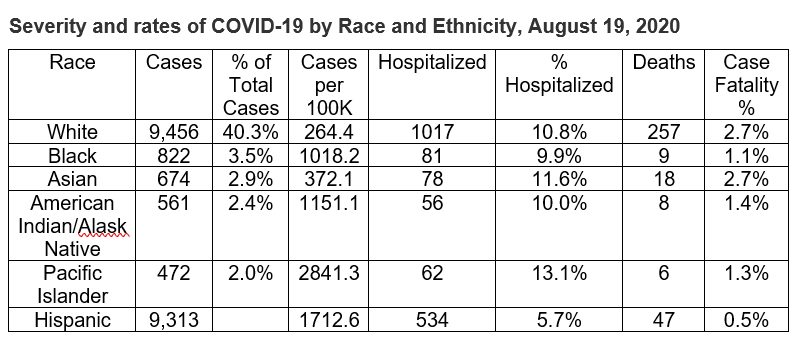 Outbreaks at Long-Term Care Facilities
The report lists outbreaks at long-term care facilities with more than five residents that have three or more confirmed cases or at least one COVID death.
This week’s report lists outbreaks in 49 (down from 53) long-term care facilities that are still considered active. They are responsible for 678 cases (down from 756) and 53 deaths (down from 64).
In addition, there are 70 outbreaks considered resolved (up from 59). They are responsible for 1136 total cases (up from 975) and 156 total deaths (up from 140). To be listed as a “resolved” outbreak, a facility must not have had a new case in at least 28 days.
The total for active and resolved facilities is thus 2,159 cases (up by 428 from last week) and 209 deaths (up by 5 from last week).
However, in addition to the listed facilities, there are 17 congregate settings with five or fewer beds that have also had three or more confirmed cases or one or more deaths, so the above totals are actually somewhat higher.
To date, there has still been only one death of a staff member reported.
Workplace Outbreaks
Similarly, there are separate listings for workplace outbreaks that are “active” and “resolved,” but without deaths identified by workplace. Case counts include all persons linked to the outbreak, which may include household members and other close contacts. To protect privacy, OHA is only reporting workplace outbreaks with five or more cases and only for workplaces with at least 30 workers.
So far, eight deaths have been the result of workplace outbreaks, a figure fortunately unchanged for more than two months.
You’ll find 88 workplaces (up from 80 last week) listed as “Active” this week, totaling 2,365 (up from 2,090 last week). Seventy-nine workplaces (up from 70) are listed as “Resolved,” totaling 1,014 cases (up from 912 last week). The total number of cases for both is thus 3,379 (up from 3,002 last week).
Those listed include workplaces with at least 5 cases identified among workers or family members. They are listed in descending order of number of cases.
You’ll notice that 642 of the cases in the Active category (more than one-fourth of the total) are in correctional institutions. Three of the top four workplace outbreaks are in fact in state correctional institutions.
Childcare Outbreaks
The Weekly Report again includes names and case counts for childcare facilities that enroll 30 or more children and have five or more cases. The same four are listed; however only one (Trout Creek Bible Camp in Corbett) is still considered active. The outbreaks at the other three centers are now considered resolved.
Without listing them by name, the Weekly Report also includes the total number of smaller facilities (i.e., enrolling fewer than 30 children) that have had five or more cases. OHA reports that there have been three such facilities
Infections by Zip Code
You’ll see that the zip code list again reveals the various hot spots around the state, presented in terms of cases per 10K residents. The top five should come as no surprise, as they’re the same as last week’s, though with #4 and #5 switching places.
- 97818 (Boardman in Morrow County)
- 97761 (Warm Springs in Jefferson County)
- 97838 (Hermiston in Umatilla and Morrow Counties)
- 97875 (Stanfield in Umatilla County)
- 97882 (Umatilla in Umatilla County)
Four out of the top five zip codes are again in the Morrow/Umatilla area. Ontario in Malheur County (97914) is again on deck at #6.
Here is a zip code locator for you to use as you look at the zip code numbers.
Where Are Today’s New Cases?
If we put together the positive test results and new “presumptive” cases reported today, the overall number of new cases is 203. Overall numbers are down, but we are continuing to see increasing cases in Jackson County (mainly in Medford, I hear). Here is the breakdown by county for today:
Baker (1)
Clackamas (15)
Columbia (3)
Crook (1)
Deschutes (4)
Douglas (1)
Hood River (1)
Jackson (24)
Jefferson (9)
Josephine (2)
Klamath (1)
Lane (5)
Linn (3)
Malheur (10)
Marion (30)
Morrow (1)
Multnomah (41)
Polk (4)
Tillamook (1)
Umatilla (11)
Union (3)
Washington (25)
Yamhill (7)
And The Deaths
All but one of today’s 11 reported deaths were from the Portland Tri-County area, which more than half from Multnomah County.
Oregon’s 398th COVID-19 death is a 70-year-old woman in Multnomah County who tested positive on August 7 and died on August 16, at Providence Portland Medical Center.
Oregon’s 399th COVID-19 death is an 83-year-old woman in Polk County who tested positive on August 4 and died on August 15, in her residence.
Oregon’s 400th COVID-19 death is a 99-year-old woman in Washington County who tested positive on August 10 and died on August 18, in her residence.
Oregon’s 401st COVID-19 death is a 93-year-old woman in Multnomah County who tested positive on August 4 and died on August 9, in her residence.
Oregon’s 402nd COVID-19 death is a 90-year-old woman in Multnomah County who tested positive on July 25 and died on August 13, at Legacy Meridian Park Medical Center.
Oregon’s 403rd COVID-19 death is a 73-year-old woman in Multnomah County who tested positive on July 16 and died on August 11, in her residence.
Oregon’s 404th COVID-19 death is an 84-year-old man in Clackamas County who tested positive on June 21 and died on August 11, at Providence Willamette Falls Medical Center.
Oregon’s 405th COVID-19 death is a 60-year-old man in Multnomah County who tested positive on July 15 and died on August 1, at Adventist Medical Center.
Oregon’s 406th COVID-19 death is an 88-year-old man in Clackamas County who tested positive on July 13 and died on July 25, at Adventist Medical Center.
Oregon’s 407th COVID-19 death is a 94-year-old man in Clackamas County who tested positive on July 30 and died on August 8, at Providence Portland Medical Center.
Oregon’s 408th COVID-19 death is an 86-year-old woman in Multnomah County who became symptomatic on August 10, after close contact with a confirmed case and died on August 14, in her residence.
Additional Graphs:
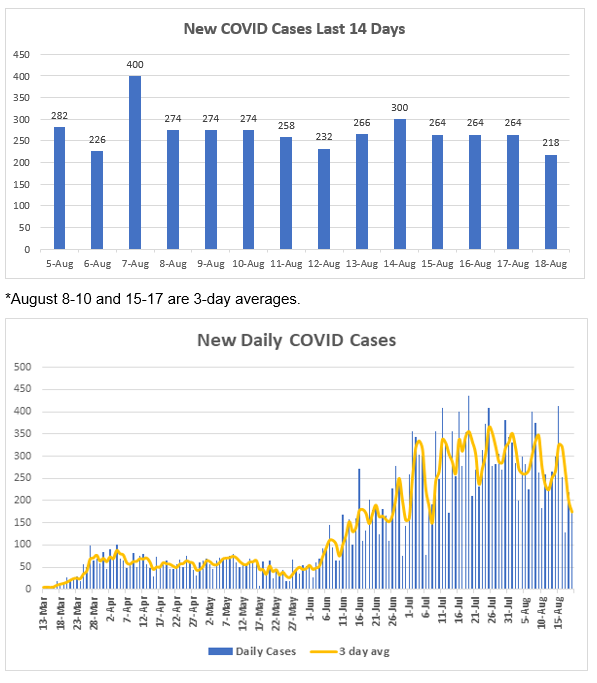 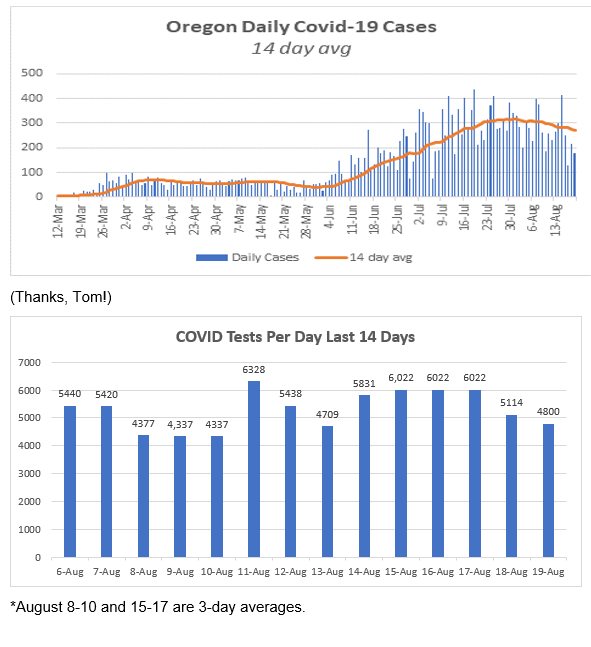   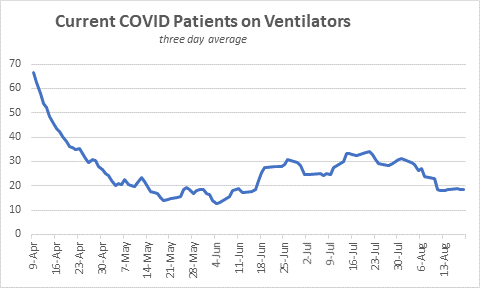
Want to See Past Newsletters?
If there was COVID-related information in a past newsletter that you want to go back to, but find you’ve deleted it, you can always go to my legislative website (senatordembrow.com), click on “News and Information,” and you’ll find them all there. Also, if someone forwarded you this newsletter and you’d like to get it directly, you can sign up for it there.
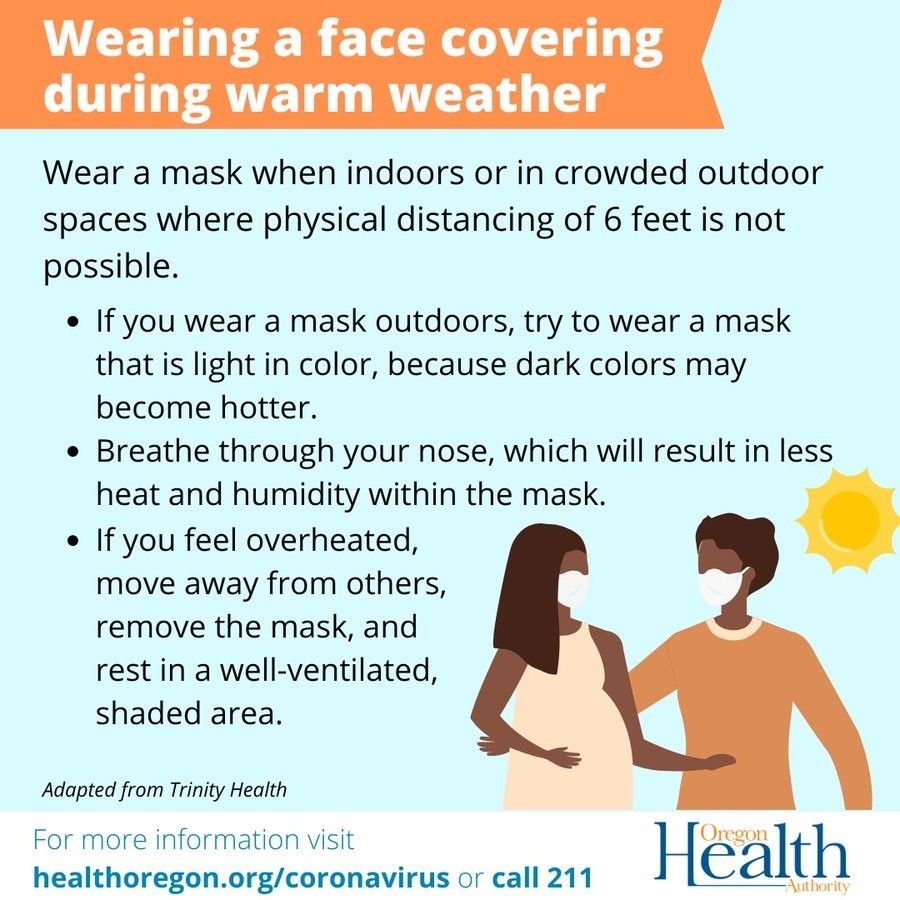
AND FINALLY,
Here again are some resources that you will find useful:
If the above links are not providing you with answers to your questions or directing you to the help that you need, please consider me and my office to be a resource. We’ll do our best to assist you or steer you in the right direction.
Best,
 Senator Michael Dembrow
District 23
email: Sen.MichaelDembrow@oregonlegislature.gov
web: www.senatordembrow.com
phone: 503-986-1723
mail: 900 Court St NE, S-407, Salem, OR, 97301
|